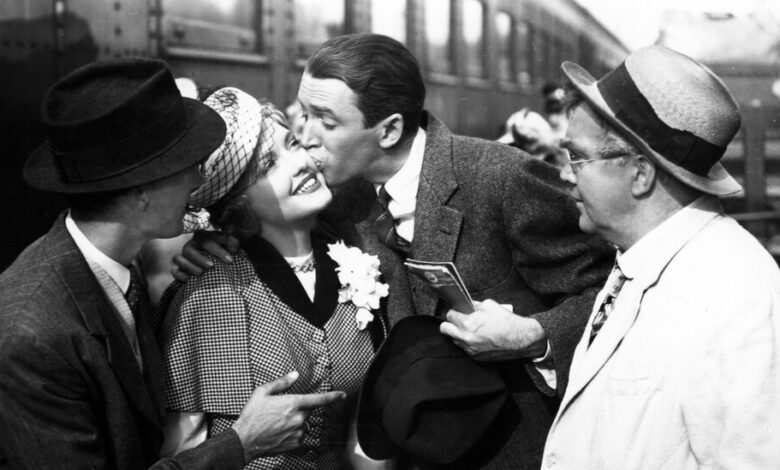Virginia Patton Moss, ‘It’s a Wonderful Life’ Actress, Dies at 97

Virginia Patton Moss, the last surviving adult member of the cast of Frank Capra’s “It’s a Wonderful Life,” who, three years after that film was released, left Hollywood to find her own wonderful life raising a family in Ann Arbor, Mich., died on Aug. 18 in Albany, Ga. She was 97.
The death, at an assisted living facility, was confirmed by her son, Michael Cruse Moss.
As Virginia Patton, she began her movie career at 18. She had appeared in 10 films, mostly in uncredited roles, when she was cast in “It’s a Wonderful Life” (1946), which stars James Stewart as George Bailey, a frustrated banker in the town of Bedford Falls who, when he faces financial ruin, contemplates suicide, but who is saved by a guardian angel who shows him what the lives of everybody in town would have been like without him.
Miss Patton appears in the film when her character, Ruth Dakin, steps off a train with George’s younger brother, Harry (Todd Karns), at the railroad station in Bedford Falls, bearing news that they had married. Harry introduces her as Ruth Dakin, but she adds confidently, “Ruth Dakin Bailey, if you don’t mind.”
“What’s a pretty girl like you doing marrying this two-headed brother of mine?” George asks.
“Well, I’ll tell you,” Ruth says. “It’s purely mercenary. My father offered him a job.”
George is shaken, realizing that if Harry takes the job, he can’t flee Bedford Falls and leave his family’s building-and-loan association to his brother to run, as he had long hoped. Then, when a still dazed George catches up to Ruth, who has walked ahead of him eating popcorn, she tells him, “George, George, George … that’s all Harry ever talks about.”
Before that scene was filmed, Miss Patton was worried that she would be eating buttered popcorn and that the camera would zoom in and show butter on her white gloves.
“We rehearsed it,” she recalled in 2013 when the St. Nicholas Institute, which promotes the ideals of Santa Claus, gave her its first Spirit of Christmases Past, Present & Future Award. Mr. Capra, she recalled, “didn’t say anything about it. His assistant didn’t say anything about it. His cameraman didn’t say anything about it.” So, she decided, “I’ll just pretend everybody eats buttered popcorn with gloves.”
Virginia Ann Marie Patton was born on June 25, 1925, in Cleveland and grew up in Portland, Ore. Her father, Donald, was an aeronautical engineer, and her mother, Marie (Cain) Patton, was a homemaker. Virginia was a great-niece of General George S. Patton, the bold World War II Army commander
After her family moved to Los Angeles, she attended classes at the University of Southern California and appeared in a play written by William C. deMille (the older brother of the director Cecil B. DeMille, who capitalized the “D” in his family’s last name). That performance led her to Hollywood.
At 18 she appeared in a musical number with Ann Sheridan in her first film, the Warner Bros. musical “Thank Your Lucky Stars” (1943); she was in a string of other Warner Bros. films before Mr. Capra signed her for “It’s a Wonderful Life.”
She appeared in four more films — including starring roles in “The Burning Cross” (1947) and “Black Eagle” (1948)— but left Hollywood for good after marrying Cruse Watson Moss, who became an automotive executive, in 1949, when she was 24.
“It’s Tinsel Town,” she said of Hollywood when she was interviewed in 2010 by Lucy Ann Lance on WLBY, a radio station in Ann Arbor, where Mrs. Patton Moss lived for most of her life. “And that’s not the life that I wanted. I got what I wanted in Ann Arbor.”
In that university town, she raised her three children and was a Boy Scout and Girl Scout leader; studied art history and archaeology at the University of Michigan; served on the boards of the Kelsey Museum of Archaeology and the Stearns Collection of Musical Instruments, both at the university; was a docent at the school’s Museum of Art; and raised funds for various organizations. She was also president of the Patton Company, her family’s real estate investment firm.
Joseph Lam, a former director of the Stearns collection, said in an email that Mrs. Patton Moss “was very creative in setting the scenes of fund-raising activities,” adding, “Her flower decorations, and other artistic details, contributed much to the artistic and jovial atmosphere of the parties.”
In addition to her son, Mrs. Patton Moss is survived by a daughter, Carol Moss Loop; seven grandchildren; and three great-grandchildren. Her husband died in 2018. Another son, Stephen, died in 1997.
When reminiscing about “It’s a Wonderful Life,” she spoke extensively about Mr. Capra and his message, delivered through the life of George Bailey, about the impact a single person’s life can have on his community.
“Capra knew we were coming out of a war, we were in terrible shape and there needed to be some type of stimulus,” she told the St. Nicholas Institute. She then rang a bell, which, in the film, signified that an angel had gotten its wings.
She added, “Go get ’em, Capra.”





